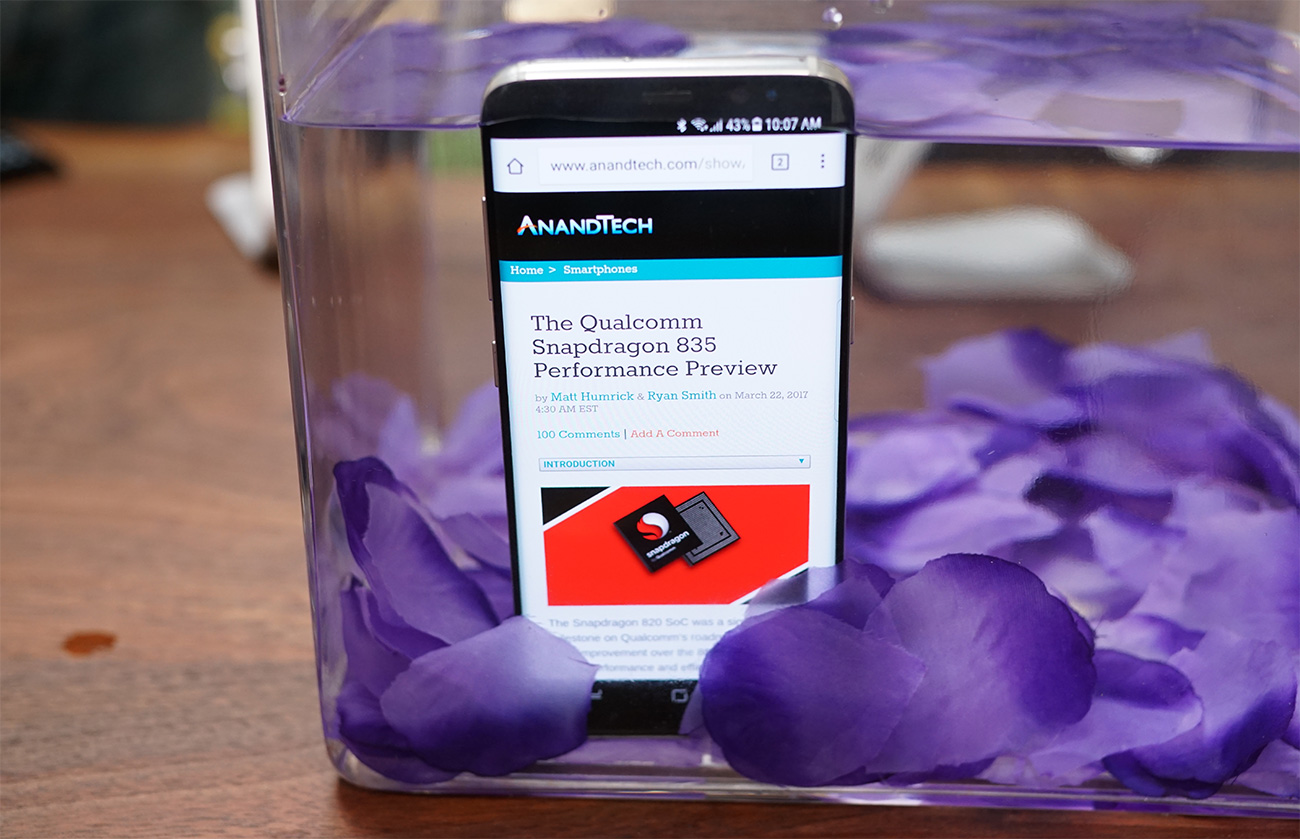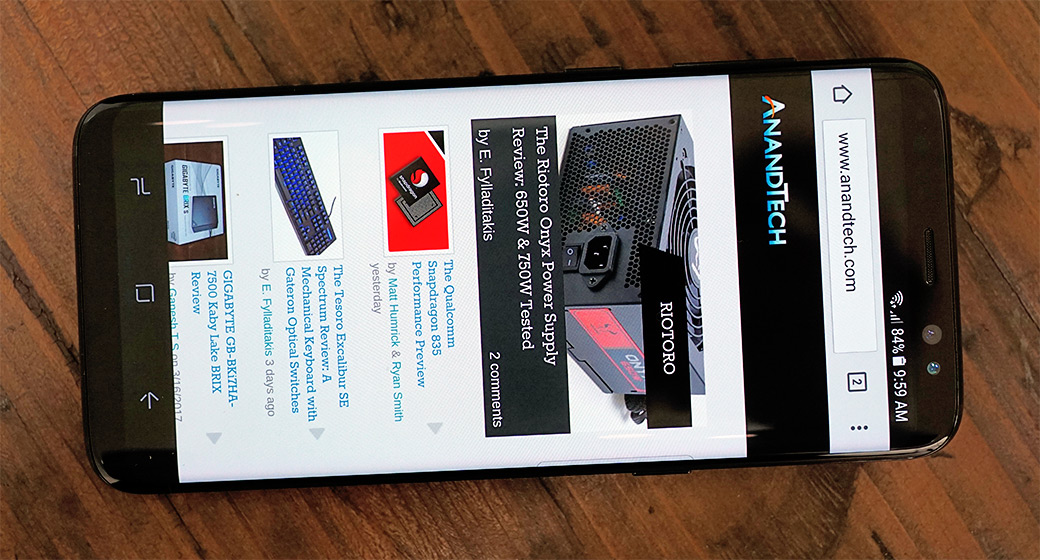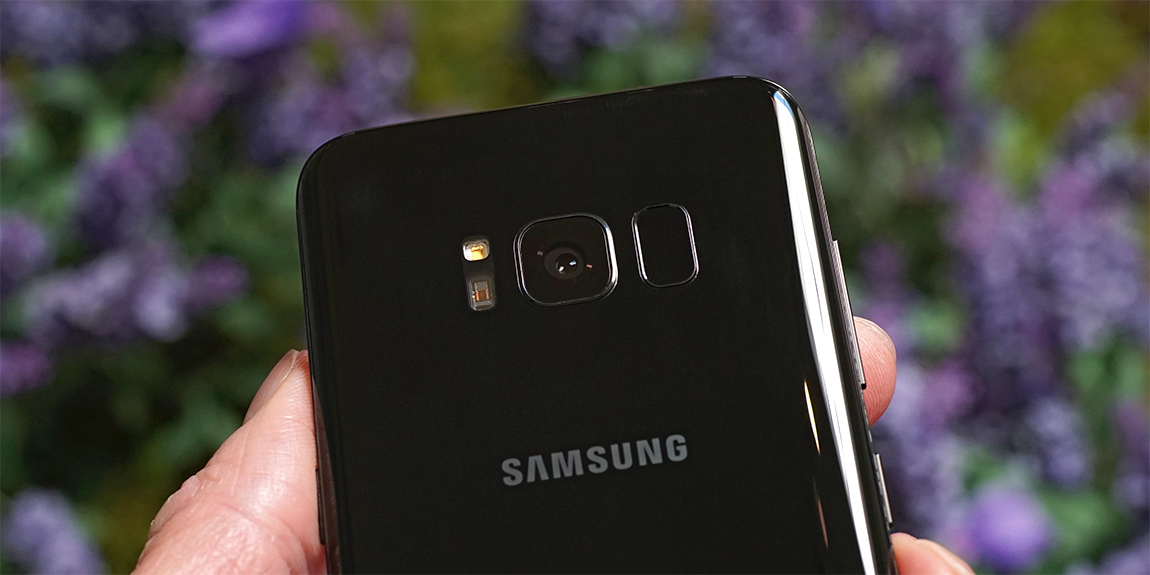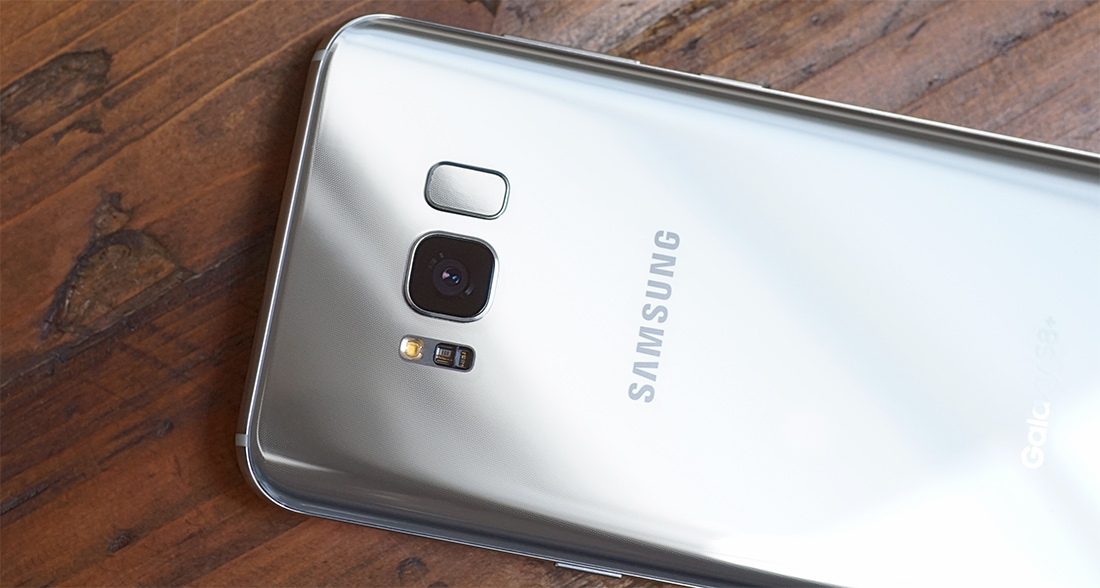Hands On With Samsung's Galaxy S8 and S8+: Taller Screens and Slimmer Bezels
by Matt Humrick on March 29, 2017 11:00 AM EST- Posted in
- Smartphones
- Samsung
- Galaxy
- Mobile
- Galaxy S8
Internal Hardware and Features
Inside the redesigned Galaxy S8 and S8+ is either a Qualcomm Snapdragon 835 or Samsung Exynos 8895 SoC. The US and other regions that require CDMA capability will get the Snapdragon 835. We already have some idea of what to expect from the 4x4 big.LITTLE Kryo 280 CPU and upgraded Adreno 540 GPU after some preliminary performance testing. We know less about the Exynos 8895, which the rest of the world will receive. When we spoke with Samsung LSI at MWC 2017, a representative told us that while the 8895 comes with a Mali-G71MP20 GPU, the GPU configuration and operating points are set by the OEM, meaning it’s possible the S8 will not use all 20 GPU cores.
| Samsung Galaxy S8 Series | ||
| Samsung Galaxy S8 | Samsung Galaxy S8+ | |
| SoC | Qualcomm Snapdragon 835 (US, China, Japan) 4x Kryo 280 Performance @ 2.35GHz 4x Kryo 280 Efficiency @ 1.90GHz Adreno 540 Samsung Exynos 8895 (rest of world) 4x Exynos M2 @ 2.30GHz 4x Cortex-A53 @ 1.70GHz ARM Mali-G71 |
|
| Display | 5.8-inch 2960x1440 (18.5:9) SAMOLED (curved edges) |
6.2-inch 2960x1440 (18.5:9) SAMOLED (curved edges) |
| Dimensions | 148.9 x 68.1 x 8.0 mm 155 grams |
159.5 x 73.4 x 8.1 mm 173 grams |
| RAM | 4GB LPDDR4 (US) | |
| NAND | 64GB (UFS 2.1) + microSD |
|
| Battery | 3000 mAh non-replaceable |
3500 mAh non-replaceable |
| Front Camera | 8MP, f/1.7, Contrast AF | |
| Rear Camera | 12MP, 1.4µm pixels, f/1.7, dual-pixel PDAF, OIS, auto HDR, LED flash | |
| Modem | Snapdragon X16 LTE (Integrated) 2G / 3G / 4G LTE (Category 16/13) Samsung LTE (Integrated) 2G / 3G / 4G LTE (Category 16/13) |
|
| SIM Size | NanoSIM | |
| Wireless | 802.11a/b/g/n/ac 2x2 MU-MIMO, BT 5.0 LE, NFC, GPS/Glonass/Galileo/BDS | |
| Connectivity | USB Type-C, 3.5mm headset | |
| Features | fingerprint sensor, heart-rate sensor, iris scanner, face unlock, fast charging (Qualcomm QC 2.0 or Adaptive Fast Charging), wireless charging (WPC & PMA), IP68, Mobile HDR Premium | |
| Launch OS | Android 7.0 with TouchWiz | |
The new SoCs are paired with 4GB of LPDDR4 RAM, the same amount that’s in the Galaxy S7, S7 edge, and most other flagship phones. Internal storage is limited to 64GB with the option to add additional capacity via microSD card. While this will be enough to satisfy most people, it would be nice to see a 128GB option for a flagship in this price bracket.
Even though overall size and thickness have increased slightly compared to the previous generation, battery capacity has not improved. The Galaxy S8 comes with a 3000mAh battery, the same size as the Galaxy S7, while the S8+ comes with a 3500mAh battery, slightly less than the S7 edge’s 3600mAh capacity. It will be interesting to see how battery life compares, considering the S8s’ larger screens contain nearly 16% more pixels, increasing power consumption if not offset by panel efficiency improvements or power savings elsewhere, such as the new 10nm SoCs. Regardless, it’s disappointing that Samsung is still prioritizing thickness over battery life.
The overall camera experience has been a differentiating feature for the past couple of Galaxy generations. Samsung gave the S7 and S7 edge a new 12MP rear camera last year that improved low-light image quality. It was also the first phone camera to use dual-pixel PDAF, which vastly improves autofocus performance by using every pixel for phase detection instead of just a handful of phase detection pixels scattered across the sensor.
While most flagships—and even some mid-range phones—are moving to dual-cameras and adding hybrid AF systems to improve performance and attract consumers’ attention, Samsung is content to reuse the S7’s rear camera for the S8 and S8+ but with updated image processing software. We’ve grown accustomed to seeing a new camera every year, but the S7’s (and now S8’s) camera is still among the best available for phones. Its combination of features (object-tracking AF, auto HDR, HDR live preview, manual mode, 2160p30/1080p60 video), quick performance (camera launch, image capture, AF, HDR processing), and excellent image quality add up to a great overall camera experience. Adding a second sensor could enable additional features, such as depth sensing for bokeh effects, or further improve image quality, but Samsung is either not willing or ready to travel that path yet.
The S8 and S8+ do get a new front-facing camera, however. The higher-resolution 8MP sensor is paired with a fast f/1.7 lens that’s capable of shooting up to QHD (2560x1440) video, although HDR, EIS, and video effects are deactivated in this mode. Samsung’s Smart AF feature uses face detection and contrast-based AF to improve image focus for selfies.

The Galaxy S8 and S8+ have an IP68 rating for water and dust resistance, so you can read AnandTech in the bath.
The new Galaxy phones come with Android 7.0 and Google Assistant. TouchWiz gets a facelift with more rounded corners to match the screen, but the most interesting new software feature is Bixby, Samsung’s new virtual assistant. This “intelligent user interface” promises expanded voice navigation, allowing you to (eventually) substitute voice commands for any touch-based actions. It’s deeply integrated into the OS already, and Samsung has an SDK available for third-party developers.
There’s more to Bixby then just telling your phone to adjust the screen brightness or open an app, however. Tapping the Bixby button in Samsung’s Camera app activates Bixby’s object recognition capabilities, allowing it to scan QR codes, process business cards, perform language translation, and provide product information and shopping links. It also learns your habits over time and provides context relevant information, reminders, and suggestions. For example, if you call your significant other on your drive home every day, Bixby will recognize this and offer to automatically dial his/her number for you. Bixby is still a work in progress, though, and it’s not clear how many of its features will be functional when the phones begin shipping.
Samsung is also announcing some new accessories alongside the Galaxy S8 phones. There’s a new version of Gear VR that’s compatible with the S8, S7, S6, and Note5 families. First announced at MWC 2017, this new model comes bundled with a touchpad controller that also enables hand tracking. Samsung’s Gear 360 VR camera also gets a refresh. It’s now capable of recording 4096x2048 H.265 video at 24fps, a slight increase over the previous version’s 3840x1920 resolution at 30fps.
Samsung's DeX docking station is a productivity-focused accessory that allows a Galaxy S8 phone to drive a desktop experience. The puck-shaped cradle includes an HDMI port, two USB 2.0 ports, and a 100Mbit/s Ethernet port for connecting the phone to an external monitor, keyboard, mouse, and wired network. The phone’s external speaker provides sound.
Instead of a stretched-out phone UI, the S8 provides a desktop environment with support for multiple, resizable windows, copy and paste between windows, and an app drawer for accessing all the Android apps installed on the phone.
The Galaxy S8 and S8+ will be available in US stores beginning April 21 and will come with Harman AKG earbuds. Pre-orders will begin at 12am ET on March 30. As an additional incentive, customers who pre-order the S8 or S8+ will receive a Gear VR with Controller for free. There’s also a premium bundle that throws in a 256GB microSD card and AKG Bluetooth headphones for an additional $99. Colors for the US include Midnight Black, Orchid Gray, and Arctic Silver. Coral Blue and Maple Gold colors will also be available in select markets. In the US, the Galaxy S8 will retail for $750, while the S8+ will cost $850.
The new Samsung Gear VR with Controller will also be available on April 21 for $129.99. The Controller can be purchased separately for $39.99.













208 Comments
View All Comments
Reflex - Thursday, March 30, 2017 - link
That is not actually true in practice. LiPO batteries were not adopted more quickly because they have lower energy density. As power efficiency has increased, LiPO has been adopted because the tradeoff for lower energy density has been increased durability. They are also generally safer and able to be shaped in ways LiON cannot be. This was pointed out back when Apple went through the transition on the MacBook line. It has been a consideration on the mobile products I've worked on as well.mkozakewich - Wednesday, March 29, 2017 - link
Honestly, an external USB battery would be just as good, and can be shared across many different phones. It also doesn't require you to turn your phone off. It's a better idea than swapping out your battery.Reflex - Wednesday, March 29, 2017 - link
To be fair, there is a use case for swappable batteries. Chaining a external USB battery off of your phone sucks if you are using your phone to take photos or videos for instance. USB batteries can cause travel complications as well (depends on airline/airport) and you have to have a cable in your pocket. I agree that it's a solution, but I can see the case for swappable batteries for some scenarios.That said, degraded battery life is a remnant of the days when most phones had LiON batteries that degraded quickly. Most mid to high end phones now use LiPO which degrades far less quickly making the ability to easily swap a battery less valuable (especially if it forces compromise on size/weight/durability/water resistance).
Something I've noticed is that people do not take into consideration their usage profile and how it changes over time as they have a phone. They assume their battery is failing when in reality they likely have half a dozen messenger apps, some OS customizations, and background processes that of course weren't there in the first few months when they got the phone. Most often when people claim to get a great improvement in battery life from swapping to a new battery I find that they also reset the phone to factory not realizing that the restored battery life was due to the reset clearing out cruft more than the battery they replaced.
voicequal - Thursday, March 30, 2017 - link
My Galaxy S4 battery swelled like a marshmallow at 3.5 yrs old. It still held a respectable charge right up to the day it failed. Replaced it no problem with a (probably knock-off) Samsung battery from Ebay. Looks like this phone is going to last another 3 yrs.twtech - Thursday, March 30, 2017 - link
I can't say with certainty that it was strictly necessary - I believed that my battery life per charge had dropped somewhat significantly and wanted to restore it to what rt was like when the phone was new.We know that these batteries lose capacity with each charge, and that running them low/completely out further degrades that capacity. So over time, having those things happen - GPS for example can empty the battery pretty quick - it seemed like time for a replacement. About $20 on Amazon for a replacement, takes less than a minute to swap it out.
BrokenCrayons - Wednesday, March 29, 2017 - link
The specs are nice, but the design is sorely lacking. I'd happily accept a 4.5 inch (ideally 4 inch) screen at some more rational resolution well below 1080 to regain bezels for a screen protector and added thickness for a user replacable battery. DeX looks interesting though. Android has come a long way and this might be a good desktop PC replacement for the vast majority of mundane PC tasks.shabby - Wednesday, March 29, 2017 - link
The galaxy s1 is the perfect phone for you, go back to the future and be amazed with a 4" screen and replaceable battery!BrokenCrayons - Wednesday, March 29, 2017 - link
The S1 lacks a modern OS and SoC. It also doesn't include DeX which, for me, would be a big deal since it'd be really nice to get a phone and then dump a desktop or laptop in the process. I've used a single core LG Optimus V as a PC replacement. It didn't have a means to push an image to an external screen which, when you've got just a 3.2 inch display, makes word processing a bit of a drag despite having a good keyboard. Tablets, on the other hand, are simply too large to be easily tucked into a pocket so they make a poor choice for mobile computing. A flexible phone sized platform would be the best way to solve that problem, but Samsung missed the mark by sealing the battery inside and making the S8 too large to carry in anything less than a purse or one of those silly looking belt holsters. It's borderline tablet sized at 5.8 inches even without a big bezel.Belard - Thursday, March 30, 2017 - link
There is an Android phone on the market that has a 4"screen that looks like an iPhone 4 clone. It's $90 at Best buy. IMHO... Any thing above 5" is too big.Wife feels that 5.5" is too small... For a screen. Ugh
BrokenCrayons - Friday, March 31, 2017 - link
Thanks for the tip. I'm probably going to need one sooner or later so I've been getting a bit more interested in shopping around for a new phone. I do agree completely with you that +5" is really too large. Yeah added screen size is nice, but there's a point where they become too large to manage easily.